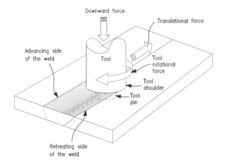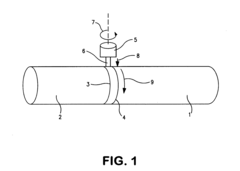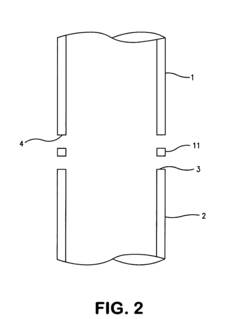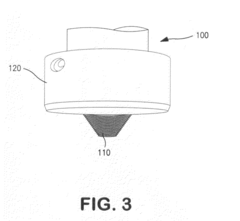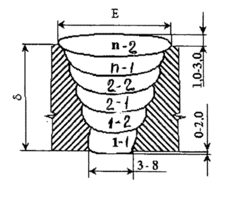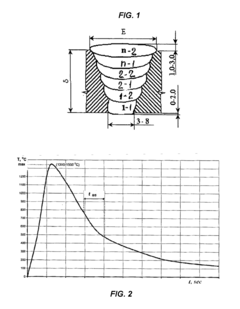Optimizing Butt Welding Processes for Enhanced Structural Integrity
MAY 12, 20259 MIN READ
Generate Your Research Report Instantly with AI Agent
Patsnap Eureka helps you evaluate technical feasibility & market potential.
Butt Welding Evolution and Objectives
Butt welding, a fundamental joining technique in structural engineering, has undergone significant evolution since its inception. This process, which involves joining two pieces of material end-to-end, has been a cornerstone in various industries, including construction, shipbuilding, and pipeline manufacturing. The historical trajectory of butt welding reveals a continuous quest for improved efficiency, reliability, and structural integrity. From manual welding techniques to the advent of automated systems, the field has witnessed remarkable advancements in both methodology and technology.
The primary objective in optimizing butt welding processes is to enhance structural integrity while maintaining or improving production efficiency. This goal is driven by the increasing demands for stronger, more durable structures in various applications, particularly in high-stress environments. The evolution of butt welding techniques has been marked by several key milestones, including the development of new welding materials, improved heat control methods, and the integration of advanced monitoring and control systems.
One of the significant trends in butt welding technology is the move towards more precise and controllable welding processes. This includes the development of advanced power sources that can deliver more stable and consistent energy, resulting in higher quality welds. Another trend is the increasing use of non-destructive testing methods to ensure weld integrity, which has become crucial in industries where weld failure can have catastrophic consequences.
The objectives of current research and development in butt welding optimization are multifaceted. Firstly, there is a focus on improving weld quality and consistency, particularly in challenging materials and environments. This includes developing techniques to minimize defects such as porosity, lack of fusion, and distortion. Secondly, there is a push towards increasing welding speeds without compromising quality, which is essential for improving productivity in industrial applications. Thirdly, researchers are working on enhancing the automation and robotization of butt welding processes, aiming to reduce human error and increase repeatability.
Another critical objective is the development of more energy-efficient welding processes. This aligns with broader industry trends towards sustainability and reduced environmental impact. Researchers are exploring ways to optimize energy consumption during welding while maintaining or improving weld quality. Additionally, there is growing interest in developing hybrid welding techniques that combine the advantages of different welding methods to achieve superior results.
As we look to the future, the optimization of butt welding processes is likely to involve the integration of advanced technologies such as artificial intelligence and machine learning. These technologies hold the promise of real-time process optimization, predictive maintenance, and even autonomous welding systems capable of adapting to changing conditions on the fly. The ultimate goal remains the achievement of perfect structural integrity in every weld, ensuring the safety and longevity of critical infrastructure and equipment across various industries.
The primary objective in optimizing butt welding processes is to enhance structural integrity while maintaining or improving production efficiency. This goal is driven by the increasing demands for stronger, more durable structures in various applications, particularly in high-stress environments. The evolution of butt welding techniques has been marked by several key milestones, including the development of new welding materials, improved heat control methods, and the integration of advanced monitoring and control systems.
One of the significant trends in butt welding technology is the move towards more precise and controllable welding processes. This includes the development of advanced power sources that can deliver more stable and consistent energy, resulting in higher quality welds. Another trend is the increasing use of non-destructive testing methods to ensure weld integrity, which has become crucial in industries where weld failure can have catastrophic consequences.
The objectives of current research and development in butt welding optimization are multifaceted. Firstly, there is a focus on improving weld quality and consistency, particularly in challenging materials and environments. This includes developing techniques to minimize defects such as porosity, lack of fusion, and distortion. Secondly, there is a push towards increasing welding speeds without compromising quality, which is essential for improving productivity in industrial applications. Thirdly, researchers are working on enhancing the automation and robotization of butt welding processes, aiming to reduce human error and increase repeatability.
Another critical objective is the development of more energy-efficient welding processes. This aligns with broader industry trends towards sustainability and reduced environmental impact. Researchers are exploring ways to optimize energy consumption during welding while maintaining or improving weld quality. Additionally, there is growing interest in developing hybrid welding techniques that combine the advantages of different welding methods to achieve superior results.
As we look to the future, the optimization of butt welding processes is likely to involve the integration of advanced technologies such as artificial intelligence and machine learning. These technologies hold the promise of real-time process optimization, predictive maintenance, and even autonomous welding systems capable of adapting to changing conditions on the fly. The ultimate goal remains the achievement of perfect structural integrity in every weld, ensuring the safety and longevity of critical infrastructure and equipment across various industries.
Market Demand Analysis for Improved Butt Welding
The demand for improved butt welding processes in various industries has been steadily increasing due to the growing emphasis on structural integrity and safety across multiple sectors. The global market for welding equipment and consumables is projected to reach $32 billion by 2025, with a significant portion attributed to advancements in butt welding technologies. Industries such as construction, automotive, aerospace, and energy are driving this demand, seeking more efficient and reliable welding solutions to enhance the overall quality and longevity of their products.
In the construction sector, there is a rising need for optimized butt welding processes in large-scale infrastructure projects, including bridges, high-rise buildings, and pipelines. The automotive industry is also pushing for improved butt welding techniques to meet stringent safety standards and lightweight vehicle designs. Similarly, the aerospace sector requires high-precision butt welding for critical components, driving innovation in this field.
Market analysis reveals that companies are increasingly investing in research and development to address the challenges associated with butt welding, such as reducing defects, improving weld strength, and enhancing overall efficiency. This trend is particularly evident in emerging economies, where rapid industrialization and infrastructure development are creating a surge in demand for advanced welding technologies.
The oil and gas industry, a major consumer of butt welding services, is experiencing a shift towards more complex offshore and deep-sea operations, necessitating robust and reliable welding solutions. This has led to a growing market for specialized butt welding equipment and services capable of withstanding harsh environmental conditions.
Furthermore, the renewable energy sector, particularly wind and solar power industries, is emerging as a significant driver for improved butt welding processes. The construction of large-scale wind turbines and solar panel support structures requires high-quality, durable welds to ensure long-term structural integrity.
As environmental regulations become more stringent, there is an increasing demand for welding processes that minimize emissions and energy consumption. This has created a niche market for eco-friendly butt welding solutions, driving innovation in this direction.
The market analysis also indicates a growing trend towards automation and robotics in butt welding processes. This is driven by the need for consistent quality, increased productivity, and reduced labor costs. As a result, there is a rising demand for advanced sensors, control systems, and AI-driven welding equipment capable of optimizing butt welding processes in real-time.
In the construction sector, there is a rising need for optimized butt welding processes in large-scale infrastructure projects, including bridges, high-rise buildings, and pipelines. The automotive industry is also pushing for improved butt welding techniques to meet stringent safety standards and lightweight vehicle designs. Similarly, the aerospace sector requires high-precision butt welding for critical components, driving innovation in this field.
Market analysis reveals that companies are increasingly investing in research and development to address the challenges associated with butt welding, such as reducing defects, improving weld strength, and enhancing overall efficiency. This trend is particularly evident in emerging economies, where rapid industrialization and infrastructure development are creating a surge in demand for advanced welding technologies.
The oil and gas industry, a major consumer of butt welding services, is experiencing a shift towards more complex offshore and deep-sea operations, necessitating robust and reliable welding solutions. This has led to a growing market for specialized butt welding equipment and services capable of withstanding harsh environmental conditions.
Furthermore, the renewable energy sector, particularly wind and solar power industries, is emerging as a significant driver for improved butt welding processes. The construction of large-scale wind turbines and solar panel support structures requires high-quality, durable welds to ensure long-term structural integrity.
As environmental regulations become more stringent, there is an increasing demand for welding processes that minimize emissions and energy consumption. This has created a niche market for eco-friendly butt welding solutions, driving innovation in this direction.
The market analysis also indicates a growing trend towards automation and robotics in butt welding processes. This is driven by the need for consistent quality, increased productivity, and reduced labor costs. As a result, there is a rising demand for advanced sensors, control systems, and AI-driven welding equipment capable of optimizing butt welding processes in real-time.
Current Challenges in Butt Welding Techniques
Butt welding, a critical process in structural fabrication, faces several challenges that impact the integrity and reliability of welded joints. One of the primary issues is the difficulty in achieving consistent weld penetration, particularly in thick materials. Inadequate penetration can lead to weak joints prone to failure under stress. Conversely, excessive penetration may cause burn-through, compromising the structural integrity. Controlling heat input is another significant challenge, as excessive heat can lead to distortion, residual stresses, and changes in material properties, while insufficient heat may result in incomplete fusion.
Alignment and fit-up of components prior to welding pose additional challenges, especially in large-scale structures or when working with materials that have different thicknesses. Misalignment can lead to stress concentrations and reduced joint strength. The presence of contaminants, such as oxides, oils, or moisture on the joint surfaces, can result in porosity, inclusions, and other weld defects, necessitating stringent surface preparation procedures.
In automated welding processes, maintaining consistent travel speed and torch positioning throughout the weld length is crucial but often challenging, particularly in complex geometries or long welds. This can lead to variations in weld quality along the joint. The selection of appropriate filler materials and shielding gases for different base materials and welding conditions also presents challenges, as incompatible choices can result in poor weld properties or increased susceptibility to cracking.
Environmental factors, such as wind in outdoor welding scenarios, can disrupt shielding gas coverage, leading to oxidation and porosity in the weld. In high-production environments, the need for increased welding speed often conflicts with maintaining weld quality, creating a challenging balance for manufacturers.
Advanced materials, including high-strength steels and aluminum alloys, present unique welding challenges due to their sensitivity to heat input and potential for cracking. The increasing demand for welding dissimilar materials further complicates the process, requiring careful control of heat input and filler material selection to prevent the formation of brittle intermetallic compounds.
Quality control and inspection of butt welds remain challenging, particularly in detecting subsurface defects without resorting to destructive testing methods. Non-destructive testing techniques, while improving, still have limitations in detecting certain types of defects, especially in complex geometries or thick materials.
Addressing these challenges requires a multifaceted approach, combining advancements in welding technology, improved process control, and enhanced operator training. Innovations in areas such as adaptive control systems, real-time monitoring, and advanced materials science are crucial for overcoming these obstacles and improving the overall quality and reliability of butt welded joints.
Alignment and fit-up of components prior to welding pose additional challenges, especially in large-scale structures or when working with materials that have different thicknesses. Misalignment can lead to stress concentrations and reduced joint strength. The presence of contaminants, such as oxides, oils, or moisture on the joint surfaces, can result in porosity, inclusions, and other weld defects, necessitating stringent surface preparation procedures.
In automated welding processes, maintaining consistent travel speed and torch positioning throughout the weld length is crucial but often challenging, particularly in complex geometries or long welds. This can lead to variations in weld quality along the joint. The selection of appropriate filler materials and shielding gases for different base materials and welding conditions also presents challenges, as incompatible choices can result in poor weld properties or increased susceptibility to cracking.
Environmental factors, such as wind in outdoor welding scenarios, can disrupt shielding gas coverage, leading to oxidation and porosity in the weld. In high-production environments, the need for increased welding speed often conflicts with maintaining weld quality, creating a challenging balance for manufacturers.
Advanced materials, including high-strength steels and aluminum alloys, present unique welding challenges due to their sensitivity to heat input and potential for cracking. The increasing demand for welding dissimilar materials further complicates the process, requiring careful control of heat input and filler material selection to prevent the formation of brittle intermetallic compounds.
Quality control and inspection of butt welds remain challenging, particularly in detecting subsurface defects without resorting to destructive testing methods. Non-destructive testing techniques, while improving, still have limitations in detecting certain types of defects, especially in complex geometries or thick materials.
Addressing these challenges requires a multifaceted approach, combining advancements in welding technology, improved process control, and enhanced operator training. Innovations in areas such as adaptive control systems, real-time monitoring, and advanced materials science are crucial for overcoming these obstacles and improving the overall quality and reliability of butt welded joints.
Existing Butt Welding Optimization Methods
01 Welding process optimization for structural integrity
Optimizing butt welding processes to enhance structural integrity involves controlling various parameters such as heat input, welding speed, and electrode selection. Advanced techniques like pulsed welding and automated systems can improve weld quality and consistency, resulting in stronger joints and better overall structural performance.- Welding process optimization for structural integrity: Optimizing butt welding processes to enhance structural integrity involves controlling various parameters such as heat input, welding speed, and electrode selection. Advanced techniques like pulsed welding and automated systems can improve weld quality and consistency, leading to stronger joints and better overall structural performance.
- Non-destructive testing methods for weld quality assessment: Non-destructive testing techniques are crucial for evaluating the structural integrity of butt welds. Methods such as ultrasonic testing, radiographic inspection, and magnetic particle testing can detect internal defects, cracks, and other imperfections that may compromise the weld's strength and durability.
- Material selection and preparation for improved weld strength: Proper material selection and preparation play a vital role in ensuring the structural integrity of butt welds. Considerations include choosing compatible materials, proper cleaning and surface preparation, and using appropriate filler metals to achieve optimal weld strength and resistance to various environmental factors.
- Post-weld heat treatment for stress relief and improved properties: Post-weld heat treatment processes can significantly enhance the structural integrity of butt welds by relieving residual stresses, improving mechanical properties, and reducing the risk of stress corrosion cracking. Techniques such as stress relief annealing and tempering can be applied to optimize the weld's performance.
- Monitoring and control systems for weld quality assurance: Advanced monitoring and control systems can be implemented to ensure consistent weld quality and structural integrity in butt welding processes. These systems may include real-time monitoring of welding parameters, automated defect detection, and adaptive control mechanisms to maintain optimal welding conditions throughout the process.
02 Non-destructive testing methods for weld quality assessment
Various non-destructive testing methods are employed to assess the quality and structural integrity of butt welds. These include ultrasonic testing, radiographic inspection, and magnetic particle testing. Advanced techniques like phased array ultrasonic testing and digital radiography provide more accurate and detailed information about weld defects and overall joint integrity.Expand Specific Solutions03 Material selection and preparation for improved weld strength
Proper material selection and preparation play crucial roles in ensuring the structural integrity of butt welds. This includes choosing compatible materials, proper cleaning and surface preparation, and using appropriate filler metals. Pre-heating and post-weld heat treatment can also significantly impact the final weld strength and overall structural performance.Expand Specific Solutions04 Stress analysis and fatigue life prediction of welded joints
Advanced computational methods and finite element analysis are used to predict stress distributions and fatigue life of butt-welded joints. These techniques help in identifying potential weak points and optimizing joint designs for improved structural integrity. Factors such as residual stresses, geometric discontinuities, and loading conditions are considered in these analyses.Expand Specific Solutions05 Innovative welding technologies for enhanced structural integrity
Emerging welding technologies are being developed to improve the structural integrity of butt welds. These include friction stir welding, laser welding, and hybrid welding processes. These advanced techniques offer benefits such as reduced heat-affected zones, improved metallurgical properties, and enhanced control over the welding process, resulting in stronger and more reliable welded joints.Expand Specific Solutions
Key Players in Welding Industry
The butt welding process optimization market is in a growth phase, driven by increasing demand for high-integrity structural components across industries. The market size is expanding, with a focus on enhancing structural integrity and efficiency. Technologically, the field is advancing rapidly, with companies like NIPPON STEEL CORP., Kobe Steel, Ltd., and JFE Steel Corp. leading innovation in Japan. Global players such as The Boeing Co. and Caterpillar, Inc. are pushing boundaries in aerospace and heavy machinery applications. European firms like Danieli & C. Officine Meccaniche SpA are contributing to automation advancements. The competitive landscape is diverse, with automotive giants Toyota Motor Corp. and Honda Motor Co., Ltd. also making significant strides in welding technology development.
Danieli & C. Officine Meccaniche SpA
Technical Solution: Danieli & C. Officine Meccaniche SpA has engineered a high-speed butt welding system for continuous production environments. Their process utilizes a combination of electromagnetic pulse welding and resistance heating. The system employs precisely controlled electromagnetic forces to rapidly bring the workpieces together, while simultaneously applying a high-current, low-voltage electrical pulse. This creates a solid-state weld with minimal heat input. Danieli's innovation includes a sophisticated control system that synchronizes the electromagnetic pulse with the resistance heating cycle, optimizing energy input and weld quality. The process is particularly suited for welding dissimilar metals and thin sections at high production rates.
Strengths: Extremely fast welding speeds, minimal heat-affected zone, suitable for automation. Weaknesses: Limited to certain material thicknesses, requires precise setup and maintenance.
NIPPON STEEL CORP.
Technical Solution: NIPPON STEEL CORP. has developed an advanced butt welding process that utilizes high-frequency induction heating combined with precise pressure control. This method ensures rapid, uniform heating of the joint area, followed by controlled forging pressure application. The process incorporates real-time monitoring of temperature distribution and deformation, allowing for adaptive control of welding parameters. Additionally, they have implemented a post-weld heat treatment system that optimizes the microstructure of the welded zone, enhancing its mechanical properties.
Strengths: Excellent weld quality, reduced heat-affected zone, high production efficiency. Weaknesses: High initial equipment cost, requires skilled operators for parameter optimization.
Innovative Approaches in Butt Welding
Butt weld and method of making using fusion and friction stir welding
PatentActiveUS20100159265A1
Innovation
- A method combining a fusion root weld with a friction stir weld, where the fusion root weld provides the necessary support for the FSW process without the need for a backing support, allowing for a strong and defect-free butt weld by adjusting the root weld size and geometry to accommodate the FSW tool's forces.
Method for welding pipelines from high-strength pipes with controllable heat input
PatentInactiveUS20160375518A1
Innovation
- A method for welding high-strength pipelines with controlled heat input, involving controlled thermal cycles, edge opening ratios, preheating, multi-layer bead application with 100% overlap, and controlled cooling using heat-insulating belts to manage heat input within the range of 0.8-1.2 kJ/mm, ensuring optimal mechanical features and reduced residual stresses.
Material Science Advancements for Welding
Material science advancements have played a crucial role in enhancing the structural integrity of butt welding processes. Recent developments in this field have focused on improving the properties of welding materials, particularly in terms of strength, ductility, and resistance to various environmental factors. One significant advancement has been the development of high-strength low-alloy (HSLA) steels, which offer improved weldability and mechanical properties compared to traditional carbon steels. These materials have been engineered to provide enhanced strength-to-weight ratios, making them ideal for applications in industries such as automotive, aerospace, and construction.
Another area of progress has been in the realm of filler materials. Researchers have developed new alloy compositions that can better match the properties of the base materials being welded, resulting in stronger and more durable joints. These advanced filler materials often incorporate nanoparticles or rare earth elements to enhance their performance characteristics. For instance, the addition of titanium dioxide nanoparticles to welding consumables has been shown to improve the microstructure and mechanical properties of the weld metal.
Advancements in surface engineering have also contributed to the optimization of butt welding processes. Techniques such as laser surface modification and plasma nitriding have been employed to enhance the surface properties of materials prior to welding. These treatments can improve the weldability of certain materials, reduce the formation of defects, and increase the overall strength of the welded joint.
The development of new coating technologies has further improved the performance of welded structures. Specialized coatings can be applied to the welded area to provide additional protection against corrosion, wear, and other environmental factors. These coatings often incorporate advanced materials such as graphene or ceramic nanoparticles to enhance their protective properties.
In the field of dissimilar metal welding, material scientists have made significant strides in developing intermediate layers or transition materials that can facilitate the joining of incompatible metals. These innovations have expanded the range of materials that can be effectively welded together, opening up new possibilities for design and manufacturing.
Furthermore, the integration of computational materials science with experimental techniques has accelerated the development of new welding materials and processes. Advanced modeling and simulation tools allow researchers to predict the behavior of materials during welding, optimize alloy compositions, and design tailored microstructures for specific applications. This approach has led to the creation of materials with improved weldability and performance characteristics, ultimately contributing to the enhancement of structural integrity in butt welding processes.
Another area of progress has been in the realm of filler materials. Researchers have developed new alloy compositions that can better match the properties of the base materials being welded, resulting in stronger and more durable joints. These advanced filler materials often incorporate nanoparticles or rare earth elements to enhance their performance characteristics. For instance, the addition of titanium dioxide nanoparticles to welding consumables has been shown to improve the microstructure and mechanical properties of the weld metal.
Advancements in surface engineering have also contributed to the optimization of butt welding processes. Techniques such as laser surface modification and plasma nitriding have been employed to enhance the surface properties of materials prior to welding. These treatments can improve the weldability of certain materials, reduce the formation of defects, and increase the overall strength of the welded joint.
The development of new coating technologies has further improved the performance of welded structures. Specialized coatings can be applied to the welded area to provide additional protection against corrosion, wear, and other environmental factors. These coatings often incorporate advanced materials such as graphene or ceramic nanoparticles to enhance their protective properties.
In the field of dissimilar metal welding, material scientists have made significant strides in developing intermediate layers or transition materials that can facilitate the joining of incompatible metals. These innovations have expanded the range of materials that can be effectively welded together, opening up new possibilities for design and manufacturing.
Furthermore, the integration of computational materials science with experimental techniques has accelerated the development of new welding materials and processes. Advanced modeling and simulation tools allow researchers to predict the behavior of materials during welding, optimize alloy compositions, and design tailored microstructures for specific applications. This approach has led to the creation of materials with improved weldability and performance characteristics, ultimately contributing to the enhancement of structural integrity in butt welding processes.
Quality Control and NDT in Butt Welding
Quality control and non-destructive testing (NDT) are critical components in ensuring the structural integrity of butt welded joints. In the context of optimizing butt welding processes, these aspects play a pivotal role in maintaining high standards of weld quality and reliability. The implementation of robust quality control measures begins with the establishment of comprehensive welding procedure specifications (WPS) and qualification of welding personnel. These foundational elements set the stage for consistent and high-quality welding outcomes.
Non-destructive testing techniques are employed extensively throughout the butt welding process to detect and evaluate potential defects without compromising the integrity of the welded joint. Common NDT methods utilized in butt welding include visual inspection, radiographic testing (RT), ultrasonic testing (UT), magnetic particle testing (MT), and penetrant testing (PT). Each of these methods offers unique advantages in identifying specific types of weld defects, such as cracks, porosity, lack of fusion, or inclusions.
Visual inspection serves as the first line of defense, allowing for the immediate detection of surface imperfections and gross defects. Radiographic testing provides a comprehensive view of the internal structure of the weld, revealing subsurface defects that may not be visible to the naked eye. Ultrasonic testing offers the advantage of real-time inspection and is particularly effective in detecting planar defects and assessing weld penetration depth. Magnetic particle testing is highly sensitive to surface and near-surface discontinuities in ferromagnetic materials, while penetrant testing excels in revealing surface-breaking defects in both ferrous and non-ferrous materials.
The integration of advanced NDT technologies, such as phased array ultrasonic testing (PAUT) and time-of-flight diffraction (TOFD), has further enhanced the capabilities of weld inspection. These methods provide improved defect detection, sizing accuracy, and visualization of weld characteristics. Additionally, the adoption of automated and robotic NDT systems has led to increased efficiency, repeatability, and reliability in the inspection process.
Quality control in butt welding also encompasses the monitoring and control of key welding parameters, including current, voltage, travel speed, and heat input. Advanced welding equipment often incorporates real-time monitoring systems that allow for immediate detection and correction of deviations from the specified parameters. This proactive approach to quality control helps minimize the occurrence of weld defects and ensures consistent weld quality throughout the production process.
The implementation of a comprehensive quality management system, adhering to international standards such as ISO 9001 and industry-specific requirements, further strengthens the overall quality control framework. This system typically includes detailed documentation, traceability measures, and continuous improvement processes to enhance the reliability and performance of butt welded joints.
Non-destructive testing techniques are employed extensively throughout the butt welding process to detect and evaluate potential defects without compromising the integrity of the welded joint. Common NDT methods utilized in butt welding include visual inspection, radiographic testing (RT), ultrasonic testing (UT), magnetic particle testing (MT), and penetrant testing (PT). Each of these methods offers unique advantages in identifying specific types of weld defects, such as cracks, porosity, lack of fusion, or inclusions.
Visual inspection serves as the first line of defense, allowing for the immediate detection of surface imperfections and gross defects. Radiographic testing provides a comprehensive view of the internal structure of the weld, revealing subsurface defects that may not be visible to the naked eye. Ultrasonic testing offers the advantage of real-time inspection and is particularly effective in detecting planar defects and assessing weld penetration depth. Magnetic particle testing is highly sensitive to surface and near-surface discontinuities in ferromagnetic materials, while penetrant testing excels in revealing surface-breaking defects in both ferrous and non-ferrous materials.
The integration of advanced NDT technologies, such as phased array ultrasonic testing (PAUT) and time-of-flight diffraction (TOFD), has further enhanced the capabilities of weld inspection. These methods provide improved defect detection, sizing accuracy, and visualization of weld characteristics. Additionally, the adoption of automated and robotic NDT systems has led to increased efficiency, repeatability, and reliability in the inspection process.
Quality control in butt welding also encompasses the monitoring and control of key welding parameters, including current, voltage, travel speed, and heat input. Advanced welding equipment often incorporates real-time monitoring systems that allow for immediate detection and correction of deviations from the specified parameters. This proactive approach to quality control helps minimize the occurrence of weld defects and ensures consistent weld quality throughout the production process.
The implementation of a comprehensive quality management system, adhering to international standards such as ISO 9001 and industry-specific requirements, further strengthens the overall quality control framework. This system typically includes detailed documentation, traceability measures, and continuous improvement processes to enhance the reliability and performance of butt welded joints.
Unlock deeper insights with Patsnap Eureka Quick Research — get a full tech report to explore trends and direct your research. Try now!
Generate Your Research Report Instantly with AI Agent
Supercharge your innovation with Patsnap Eureka AI Agent Platform!
